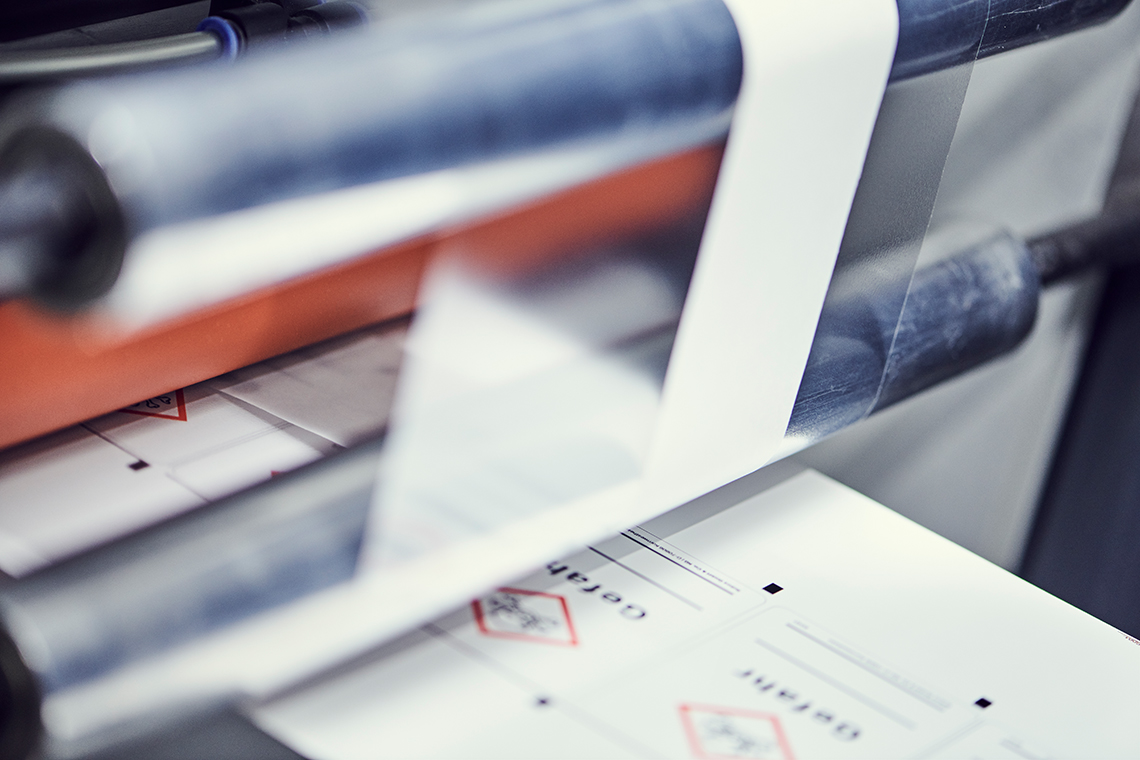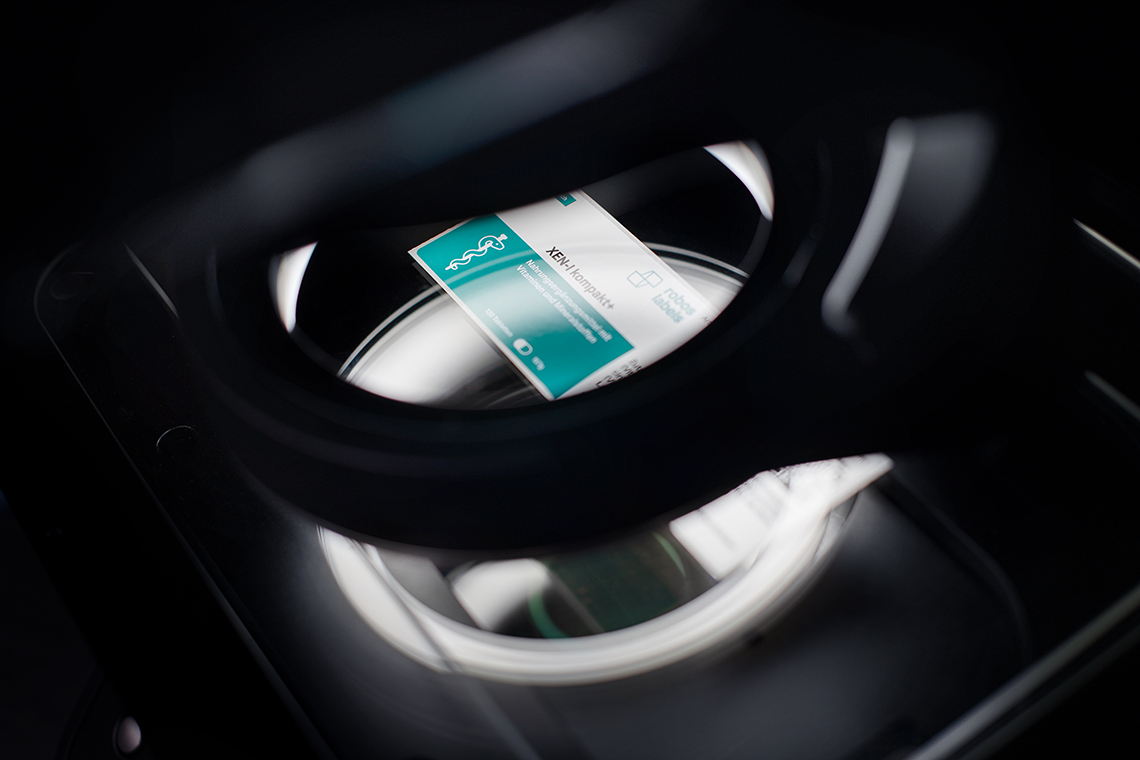Flexible and individual
Postpress
The postpress is the last manufacturing step. It includes, along with refinement with lacquers and laminates, also the die-cutting of the products to the end format as well as the creation of perforations. In addition, there are tasks like the breaking out of punched parts, the grooving and slitting of flaps, the separation of big rolls to small rolls, and if necessary also the processing to sheet goods. Besides, it also includes the lamination of diverse materials and/or adhesives as well as the creation of booklet labels.
The camera-supported inprocess control accompanies single manufacturing steps here as well. Above that, we have a digital measurement projector for the check of dimensional accuracy and for the creation of inspection reports. It automatically takes over the adjustment, focusing and measuring to achieve consistent and recreatable results. And this is independent on the user, who operates the measuring projector.
Booklet production
A booklet label is a combination of a basic label and a booklet, the so-called folded part. This folded part can contain up to 36 pages of information and is also free designable in form and content.
Our booklet plant combines a booklet-topper, a lamination unit, and punching- and lacquer unit, which can apply a trace of an adhesive so the folded part will be firmly attached to the substrate. Alternatively, the booklet labels can be refined with a laminate, e.g. to be able to include special protective functions or haptic and optic elements. In addition, there is an option of imprinted basic label, which offers a possibility for additional information.
Special features of booklet labels
The outstanding feature of booklet labels is their large space offer on a small basic area. This way extensive information in different language variants can be placed on the product directly. For that not only warning- or safety cautions but also user cautions or service options can be considered.
An absolute specialty here is the weather-resistant booklets, which were designed especially for the outdoor use in demanding environments.
Die-cutting technology
The die-cutting of labels is science of its own, because complex labeling products will be made of the demanding raw- and adhesive material combinations. In addition, there are complex die-cutting shapes with elaborate outer and inner contours. The art in the die-cutting process consists of separating the upper material in the way it becomes freely processible without damaging the siliconized substrate. For that we apply flexible punching plates which will be mounted to magnetic cylinders. For special applications in rotatory area punching cylinders, partly with pressure air unit, will be applied. These come into action in case there is waste from die-cutting which cannot be gridded off. These solid punches with a pressure air connector work in combination with a vacuuming device and blow the compressed air through the air canals precisely onto spots to be removed, which will be safely vacuumed and disposed afterwards.
Refinement
Along with optical reasons, the refinement of labeling products has mostly a protective function. An optical surface refinement will be mainly realized with lacquers. On the contrary, the protective features will be achieved rather with laminates, which are in stock in different material thicknesses depending on the requirements. Here even polycarbonates can be applied to be able to make the surfaces e.g. scratch-resistant or more resistant against impacts.
In general, refinement options can represent a matte or rather glossy appearance, whereby the thicker the chosen laminate the more it can affect the color appearance of the image printed below. Additionally, haptic elements are available as refinement as well like e.g. very soft appearing surface, or subsequently imprintable laminates. Especially the latter have great importance in the technical industrial environment, because the applied labels must be imprinted again with variable data in thermal transfer printing method during the manufacturing process on site.
Measurement projector
Complex printing products require high-tech automation-, inspection- and measurement solutions on our printing and processing machines. Here the measurement systems in manufacturing process, for the final result control and within the frame of complex sampling come into action. E.g. printing images, codes, variable data and geometries will be examined.
The new generation of measurement systems, which completes high-precision measurements within few seconds, is also available. Together with our partner, KEYENCE DEUTSCHLAND GmbH, we have decided to the use of a digital measurement projector. Just place an object and push the button and let the measurement results and protocols be automatically created. With the measurement projector up to 99 measurements can be tested within 3 seconds. Over an area of 220 x 300 mm (approx. 7.9 x 11.8 inch) up to 100 parts can be measured simultaneously. Different functions ensure that the measurements remain consistent and user independent.
Special features of booklet labels
The outstanding feature of booklet labels is their large space offer on a small basic area. This way extensive information in different language variants can be placed on the product directly. For that not only warning- or safety cautions but also user cautions or service options can be considered. An absolute specialty here is the weather-resistant booklets, which were designed especially for the outdoor use in demanding environments.Complex printing products require high-tech automation-, inspection- and measurement solutions on our printing and processing machines. Here the measurement systems in manufacturing process, for the final result control and within the frame of complex sampling come into action. E.g. printing images, codes, variable data and geometries will be examined.
The new generation of measurement systems, which completes high-precision measurements within few seconds, is also available. Together with our partner, KEYENCE DEUTSCHLAND GmbH, we have decided to the use of a digital measurement projector. Just place an object and push the button and let the measurement results and protocols be automatically created. With the measurement projector up to 99 measurements can be tested within 3 seconds. Over an area of 220 x 300 mm (approx. 7.9 x 11.8 inch) up to 100 parts can be measured simultaneously. Different functions ensure that the measurements remain consistent and user independent.


